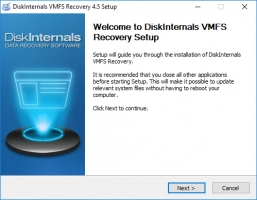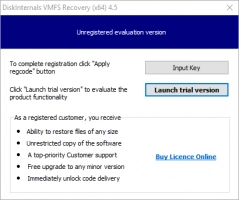How to fix/repair corrupted VMDK files
VMware’s VMDK file format is the most flexible and commonly used virtual disk format for a virtualized environment. This file format supports up to 62 TB of storage and implements lots of VM-friendly features. But then, VMDK files can get corrupted, making the connected VM(s) inaccessible. In such situations, you need to fix or repair the corrupted VMDK file to regain full access to your virtual machine – this article explains all you need to know.
This article is dedicated to how to fix the VMDK file and how to repair corrupt VMDK. Read it to find out all that you need!
What is a VMDK file?
Virtual Machine Disk (VMDK) file is VMware’s proprietary file format for virtualization platforms. A VMDK file contains all data of a virtual machine hosted in a VMware virtualization environment. So basically, a VMDK file represents a VMware virtual machine; if a VMDK file is corrupt or tampered with, your VMware Broadcom virtual machine won’t run smoothly, or may not even launch at all.
A VMDK file contains two sub-files: the descriptor file (.vmdk) and a binary file (-flat.vmdk). If the descriptor file is corrupt, you have to repair it for your VMware VM to continue and take snapshots. There are several reasons why a VMDK file may get corrupted.
Causes of Corrupt VMDK Files
VMDK files can get corrupt for the same reasons your regular files get corrupt, irrespective of the fact that they are “virtual” files. That said, hereunder are some common reasons for VMDK file corruption.
- Improper Shutdowns: If you frequently do not shut down your VMs properly before carrying out advanced tasks, such improper shutdowns can lead to VMDK file corruption.
- Hard Drive Errors: When the physical hard drive has logical errors or corrupt partitions, it could affect your VMDK files.
- System Crashes: Actions such as OS crashes, hard drive crashes, and sudden power surges can all cause file corruption, including VMDK files.
- Software Bugs: Yes, software bugs can also cause VMDK file corruption, so be careful of the software programs you install on a VM.
Virus/Malware Attacks: Of course, this cannot be overemphasized. Virus or malware attacks on a PC would definitely lead to file corruption.
How to Fix a Corrupt VMDK File? Consider These Methods!
There are quite different workarounds for repairing problematic VMDK files; however, the methods below are the best to try out.
1. Using Command Prompt
- Launch the Command Prompt as an administrator
- Confirm the file path of the corrupt VMDK file; VMDK files are usually stored in C:\Program Files\VMware\Virtual Disk Development Kit\bin
- Now, after you have confirmed the path of the VMDK file on your system, run this command: vmware-vsdiskmanager.exe – R “path to the VMDK file” (e.g. vmware-vsdiskmanager.exe – R “C:\Program Files\VMware\Virtual Disk Development Kit\bin”)
2. Rebooting the Machine
Sometimes, rebooting the virtual machine may help to fix file system errors caused due to improper shutdown. So, shut down the VM completely and then power it back to check if the errors will go away.
3. Restoring the VM from Backups
This is for IT admins who make prior backups. You can restore the good version of your VM’s VMDK file from a backup you made earlier. Restoring a VM from a backup depends on how you made the backup and which tool was tool; if you used a third-party tool for the backup, you must use the same tool to restore the backup.
4. Repair Corrupt VMDK with VMFS Recovery
DiskInternals VMFS Recovery software is a professional software program for repairing VMDK files and recovering lost VMware VM files. The software is intuitive to use and integrates a lot of handy features. Using DiskInternals VMFS Recovery, you can repair VMDK descriptors and binary files; the software has been proven by lots of IT experts for over 15 years and counting.
- Step One: Download and install DiskInternals VMFS Recovery on your Windows PC and launch it.
- Step Two: Close the Wizard that automatically pops up when you launch the program.
- Step Three: Click on “Drives” on the top menu and select Mount Image. Then browse and import the problematic VMDK files.
- Step Four: You can now access the VMDK image file as a local drive. Look to the top menu and select “Wizard” to re-launch the recovery wizard you closes earlier. Following the Wizard’s prompts, select the problematic VMDK file and choose Full Recovery mode for the best results.
- Step Five: During the scan, DiskInternals VMFS Recovery will automatically examine the VMFS datastores, volumes, disks, and RAID (if used), and attempt to repair the VMDK image(s) if it’s inaccessible.
- Step Six: After the scan, VMFS Recovery will recover the descriptor or binary file of the VMDK image, which could be the reason for its corruption. Then you can restore the recovered file(s) and your VMDK image is fixed -transfer the VMDK file back to your ESXi server.
Fix corrupted VMDK files of ESXi! Use this detailed guide!
Repairing a virtual disk in VMDK (Virtual Machine Disk) format involves several steps and can vary depending on the specific issue you're facing with the disk. Here's a detailed guide to help you troubleshoot and repair corrupt VMDK files:
1. Identify the Problem
First, determine the nature of the problem with the VMDK file. Common issues include:
- File corruption due to improper shutdowns or system crashes.
- Inaccessibility caused by configuration errors.
- Disk space issues where the VMDK is not expanding.
2. Backup the VMDK File
Before making any changes, ensure you have a backup of the VMDK file. You can copy the file to another location on your host machine or an external storage device.
3. Using VMware Tools
If you're using VMware by Broadcom, it provides tools and utilities that can help in repairing VMDK files:
VMware Disk Mount Utility
- This tool allows you to mount a VMDK file directly on your host system without running the virtual machine. Once mounted, you can check for file system errors or recover files.
VMware vSphere CLI
- Use commands like
vmkfstoolsto check the integrity of the VMDK file. For example, to check a disk, you might use:bashvmkfstools -x check
4. Repair File System Errors
If the VMDK file mounts successfully, but the file system within it is corrupted, use native file system repair tools:
- For Windows guest systems, use
chkdsk. - For Linux guest systems, use
fsck.
5. Using Third-Party Tools
Several third-party tools, like DiskInternals VMFS Recovery software can help repair VMDK files.
6. Re-create the Descriptor File
If the descriptor file of the VMDK is missing or corrupted, you might need to recreate it manually. The descriptor file contains metadata about the disk layout:
- Create a new text file with the same name as your VMDK file but with the extension
.vmdk. - Fill it with the correct metadata, which includes disk size, identifier, and other configuration details.
7. Expand Disk Space
If the issue is due to insufficient disk space on the VMDK, expand it using VMware’s disk management tools or the vSphere interface.
8. Contact Support
If you're unable to resolve the issue using the above methods, consider reaching out to VMware support or a professional data recovery service.
9. Restore from Backup
If all else fails, the most reliable method is to restore the VMDK file from a backup if one is available.
Tip: learn more on how to recover corrupted VMDK!Recovering Specific VMDK Files
These are other methods of recovering specific VMDK files, such as the descriptor file or the binary file.
1. Mount the VMDK File to Another VM
If a VMDK file is partially corrupted and won’t boot your VM, you can boot the VM from a disc. You can then run the VMDK file as an ISO disk image mounted to a virtual drive to access and recover data to an externally connected storage. For example, a USB drive. This is quite a complex technique for VMDK repair, but it works – when done perfectly.
2. Regenerate the Descriptor File
Regenerating the VMDK generator file may help to fix the file, but this strictly applies to situations where the descriptor file is missing, or you confirm that the descriptor file is the reason your VMDK file is inaccessible. Signs that your VMDK file is inaccessible because of a missing or corrupt descriptor file include:
- The VM disk file shown in Datastore Browser is VMDK’s flat file, and it does not have an icon.
- When you see the following error while booting the VM: “File not found” error.
- You only see the VMDK flat file when viewing the VM directory.
- The descriptor file is missing
3. Use Virtual Machine Replicas
Yes, you can use VM replicas to fix VMDK files that are corrupt. What this means is setting up a new VM (on a new datastore, probably) using the same template and features as the old one with a corrupt VMDK file. But VM replicas are not as reliable as typical backups.
Tip: how to install VMware tools on UbuntuHow to Prevent VMDK Data Corruption?
This may not be the first time you’ve heard this, but making regular backups remains the best way to not lose your VM file in any given scenario. Also, proper VM management using the right tools, and ensuring that your host system’s hardware is reliable and efficient are some other ways to prevent VMDK file issues to an extent.


